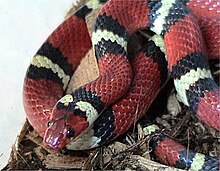Kingsnake
| Kingsnakes | |
|---|---|

| |
| Scarlet kingsnake (Lampropeltis elapsoides) | |
| Scientific classification | |
| Domain: | Eukaryota |
| Kingdom: | Animalia |
| Phylum: | Chordata |
| Class: | Reptilia |
| Order: | Squamata |
| Suborder: | Serpentes |
| Family: | Colubridae |
| Tribe: | Lampropeltini |
| Genus: | Lampropeltis Fitzinger, 1843 |
| Synonyms | |
|
Ablabes, Anguis, Bellophis, Calamaria, Coronella, Herpetodryas, Natrix, Ophibolus, Osceola, Phibolus, Pseudelaps, Zacholus[2] | |
Kingsnakes are colubrid snakes. They are members of the genus Lampropeltis, which include milk snakes and four other species. There are many subspecies, and experts differ on their classification. These snakes are mostly found in North America and Central America.
They use constriction to kill their prey. They prey on other snakes, including venomous snakes. They are immune to the venom. They also eat lizards, rodents, birds, and eggs.[3]
Their colouration is an example of Batesian mimicry, because it is very similar to venomous coral snakes living in the same areas. This gives the kingsnakes protection from the birds which prey on them.[4]
References[change | change source]
![]() Media related to Lampropeltis at Wikimedia Commons
Media related to Lampropeltis at Wikimedia Commons
- ↑ "Fossilworks: Lampropeltis". Archived from the original on 2018-12-02. Retrieved 2020-01-07.
- ↑ Wright A.H. and A.A. Wright. 1957. Handbook of Snakes of the United States and Canada. Comstock. Ithaca and London. 1,105 pp. (in 2 volumes) (Genus Lampropeltis, p. 330.)
- ↑ Conant R. 1975. A field guide to reptiles and amphibians of Eastern and Central North America. 2nd ed, Boston: Houghton Mifflin, genus Lampropeltis, p. 201. ISBN 0-395-19977-8
- ↑ Kikuchi, David W. & Pfennig, David W. 2010. Predator cognition permits imperfect coral snake mimicry. The American Naturalist. 176 (6): 830–834. [1]
